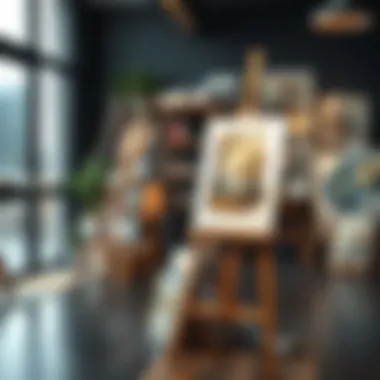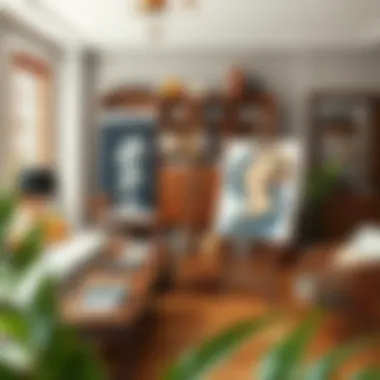Essential Guide to Art Easels and Supplies


Intro
Art is often the reflection of the artist's soul, an expression that spills onto the canvas, driven by passion, frustration, or simple whim. To truly harness this creative energy, one must not overlook the significance of the tools and environment surrounding them. An artist's easel serves as both a functional piece of furniture and a significant part of their artistic identity. This guide seeks to explore the multifaceted aspects of easels and supplies, providing artists of all levels with insights into components that elevate their practice.
Consider the easel as the anchor in an artist’s workspace, dictating the dynamics of both technique and comfort. Coupled with the right supplies, it can transform a simple idea into a masterpiece. As we navigate through modern trends, organization techniques, and innovative supplies, our focus will remain on the intersection of utility and artistry. Whether you're setting up a cozy corner in your home studio or redecorating a professional space, understanding the fundamentals of easels and supplies is essential for enhancing your creative journey.
Furniture Styles and Trends
Modern vs. Traditional: Understanding the Aesthetics
When it comes to easels, styles can vary as wildly as the artists who use them. The choice often hinges on aesthetic preferences and functional needs. Modern easels tend to embrace minimalism, often constructed from sleek metals or woods. They are designed with portability in mind, enabling artists to easily transport their creative setup. Folding models are especially popular, offering space-saving options for those with limited studio space.
In contrast, traditional easels showcase craftsmanship, often constructed from sturdy wood, demonstrating fine joinery. They capture the essence of classic artistry, providing a robust and stable platform ideal for heavy canvases.
"Choosing the right easel is like choosing your paintbrush; it should feel natural and inspire your creativity."
Color and Material Trends: What's In and What's Out
In recent years, there has been a noticeable shift in the materials used for easels. Artists are increasingly favoring sustainable materials, such as bamboo and recycled metals. This trend aligns with a growing consciousness surrounding environmental impacts, reflecting a desire to maintain a responsible and ethical approach to art making.
On the color front, the once-popular natural wood finishes are complemented by bold hues like matte black or vibrant primaries, aimed at energizing the workspace. Unconventional combinations of colors further highlight personal expression, allowing artists to curate a studio environment that resonates with their styles.
Furniture Care and Maintenance
Tips for Prolonging the Life of Your Furniture
Owning quality easels and art supplies comes with the responsibility of maintenance. Here are practical tips to keep your art furniture shining:
- Regular Cleaning: Dust can accumulate quickly. A gentle wipe with a damp cloth can keep surfaces pristine.
- Avoid Extreme Conditions: Avoid placing easels in direct sunlight or damp areas to prevent warping or cracking.
- Routine Checks: Periodically inspect joints and hinges to prevent wear and ensure stability during use.
DIY Repair Hacks for Common Furniture Issues
Accidents happen; a well-placed coffee cup can lead to a ring or a particularly energetic painting session might scratch the surface. Here are simple fixes:
- Water Marks: For water marks, a solution of equal parts vinegar and olive oil can help restore wood’s sheen.
- Scratches: A walnut can do wonders. Rubbing it on scratches can help mask them, thanks to the natural oils in the nut.
- Stability Issues: Loose screws can be tightened with a screwdriver. If a leg is uneven, felt pads can be added to balance the easel.
As we explore the dynamics of easels and the supplies that support the creative process, remember that the right tools will not only enhance your work’s quality but also foster an environment where creativity can flourish. Making informed decisions about these essential components can seamlessly elevate your artistic experience.
Understanding Art Easels
Art easels serve a significant role in the creative process for various types of artists. Their purpose goes beyond merely being a platform to hold canvases. An easel can influence an artist's workflow, reduce strain during long hours of painting, and even inspire creativity through its design and functionality. Adjustments in height or angle can enhance the artist's perspective, allowing for a more comfortable and tailored approach to creating art. Choosing the right easel is not just about preference but understanding how it integrates into one’s creative process.
The Purpose of an Art Easel
The purpose of an art easel goes hand in hand with its ability to provide stability and accessibility when creating artwork. While it acts as a simple support for a canvas, it also contributes to the artist's experience by enabling better posture. It allows artists to engage more dynamically with their work, whether they are applying broad strokes or detailed lines.
Moreover, an easel can adjust to different heights and styles of painting—be it standing to work on large pieces or kneeling for more intricate detail work. By leveraging an easel, artists maintain an ergonomic setup, lessening physical stress and enabling them to stay focused on their creative journey.
Types of Art Easels
Art easels come in various forms, each designed for specific settings and techniques. Selecting the right kind is crucial in achieving optimal comfort and efficiency in artistic endeavors.
Tabletop Easels
Tabletop easels are compact and ideal for those who may work in smaller spaces or prefer a more intimate setup. They are portable yet sturdy, providing just enough support for sketches and small canvases.
A key characteristic of tabletop easels is their ease of use; artists can easily position them on a desk or table, making them accessible for both painting and drawing. The unique feature of a tabletop easel is its versatility; they often come with adjustable angles to accommodate varying artistic needs. However, one downside is that they may not support larger canvases well, limited by their smaller size.
Field Easels
Field easels, designed with outdoor artists in mind, emphasize portability and quick setup. They are usually lightweight and can be easily collapsed for transport. The primary characteristic that stands out is their weather-resistant materials, crucial for artists who venture out to capture landscapes and scenes.
Field easels' unique feature lies in their stability on uneven ground, a must-have for any outdoor setting. Nevertheless, they might not provide the same robustness as studio easels, often sacrificing some sturdiness for ease of transport.
Studio Easels
Studio easels dominate the creative space for many dedicated artists. They are larger and sturdier than their counterparts, made explicitly for consistent use in a home or professional studio. The stability they offer is indispensable, allowing artists to work confidently on larger pieces without fear of wobbling or toppling.
A standout feature of studio easels is their substantial height adjustment, supporting a variety of working positions. However, the trade-off is less portability; these easels tend to be more cumbersome, making relocation difficult without some effort.
Convertible Easels
Convertible easels bring an element of versatility unmatched by other types. They can adapt between tabletop and studio configurations, catering to artists’ needs as they evolve. This flexibility is a notable characteristic, especially beneficial for those who may have limited space but still desire functionality.
The unique feature of convertible easels is their capacity to accommodate various formats and styles of work. Yet, one disadvantage might be their complexity in construction, which sometimes complicates the quick adjustments that artists often seek.
Key Features to Consider
When selecting an art easel, certain features should be at the forefront of an artist's mind, each adding to the overall functionality and comfort in their creative process.
Stability
Stability is paramount when it comes to choosing an easel. An unstable easel will not only hamper the execution of fine details but can also lead to frustration during the creation process. An essential characteristic of stability is the base construction; sturdier materials lead to better support.
The unique advantage of having a stable easel is confidence—artists can invest themselves fully in their work without distractions or mishaps.
Adjustability
Adjustability allows artists to tailor their easel to their specific needs. Features that allow for height and angle modifications enable users to create in a way that feels most natural to them. A key benefit of adjustable easels is their support for different painting styles and mediums.
On the flip side, complex adjustments can become a nuisance and can take up precious creative time.
Portability
Portability is often crucial for artists who prefer to work in various locations, be it outdoors or in different studios. Lightweight materials and foldable designs can assist artists in transporting their equipment with ease. The main characteristic of portability is convenience, enabling spontaneous artistic inspiration wherever it strikes.
However, portable easels can sacrifice sturdiness, so it's important to find a balance between ease of transport and reliability.
Material
Material composition impacts not only the weight of the easel but also its durability and overall aesthetic. Common materials range from wood to metal, each having its advantages and disadvantages. A significant characteristic is how material affects the ease of adjustment and stability.
For instance, wood offers a traditional look and might feel more robust, whereas aluminum can provide lightweight stability.
Choosing the right material adds to the easel’s overall value in contributing to a comfortable and effective workspace.


Essential Supplies for Artistic Endeavors
When embarking on a creative journey, the supplies one chooses can significantly impact the outcome of an artwork. The right materials not only enhance the artistic experience, but also empower the artist’s imagination. This section will dive into the critical supplies an artist should consider, highlighting the essential components integral to refining their craft.
Types of Paints
Oil Paints
Oil paints are widely recognized for their rich, vibrant colors and their ability to blend seamlessly. They dry slowly, giving artists ample time to work and rework their compositions, allowing for detailed layering and intricate textures. This characteristic makes oil paints especially popular among portrait painters and those who enjoy classical styles of art.
A key feature of oil paints is their versatility. They can be thinned with solvents like turpentine or linseed oil, enabling a variety of techniques from glazing to impasto. Although cleaning brushes requires a bit more effort compared to acrylics, the results often justify the additional time required.
However, oil paints also come with disadvantages. The drying process can be slow, posing challenges for artists who prefer working quickly. Moreover, they often require careful ventilation due to the fumes from solvents used in the painting process.
Acrylic Paints
Acrylic paints have gained a notable reputation due to their quick-drying nature and vivid, flexible colors. They can be used on a variety of surfaces, which makes them a favorite among artists dabbling in mixed media. Acrylics allow for building textures swiftly, making them suitable for both large canvases and detailed small works.
The adaptability of acrylics is one of their strongest attributes. They can mimic the appearance of oil paints when used wet-on-wet and can transform into a watercolor-like effect when diluted with water. This makes acrylics a beneficial choice for artists exploring different styles or working on experimental pieces.
Nevertheless, there are considerations to keep in mind with acrylics. Once dry, they can be difficult to rework, and they may not exhibit the same depth of color as oils. Additionally, some artists find that fast drying times can hinder blending.
Watercolor Paints
Watercolor paints are particularly loved for their transparency and their ability to create soft, luminous effects. They’re perfect for artists who prefer delicate washes and subtle color gradations. The uniqueness of watercolors allows for spontaneous and expressive strokes, giving the artist a chance to capture fleeting moments in their art.
A key feature of watercolor paints is their portability and ease of cleanup. All one needs is water to activate them, making them an ideal choice for fieldwork or sketching on the go. Furthermore, watercolor paper is often lighter than traditional canvas, further enhancing its mobility.
Despite their advantages, watercolors require a certain level of skill to master, as mistakes can be difficult to correct once the paint is dry. Additionally, achieving vibrant colors may require multiple layers—a process that can be challenging for beginners.
Brush Varieties and Their Uses
Flat Brushes
Flat brushes are essential tools in any artist's kit. Their unique shape allows for broad, sweeping strokes as well as fine lines when turned on their side. These brushes are highly favored for creating sharp edges and filling in larger areas efficiently. Flat brushes work effectively with both oils and acrylics, making them versatile.
One advantage of flat brushes is their ability to create crisp lines, which is something many artists seek for precision work. However, due to their shape, they may not be as effective for detailed textured work compared to round brushes.
Round Brushes
Round brushes are fantastic for detail work and intricate designs. Their tapered tip allows for both fine lines and broader strokes depending on the pressure applied. They excel in painting delicate features in portraits or handling the challenging strokes often required in watercolor techniques.
The flexibility of round brushes enhances an artist’s ability to transition between different techniques smoothly. That said, artists should be aware that if too much pressure is applied, they may lose their shape or become frayed, affecting their performance.
Fan Brushes
Fan brushes have a distinct, fringe shape, which makes them ideal for creating texture and effects like foliage in landscapes, or fur in animal portraits. Their unique design allows for soft blending or robust stippling.
One of the advantages of fan brushes is their ability to mimic natural patterns, adding realism to a piece. However, they can be somewhat limited in versatility, especially for broader strokes or detailed areas. Artists need to be mindful not to overuse them, as they might result in a more chaotic look if not controlled properly.
Selecting the Appropriate Canvas
Stretched Canvas
Stretched canvas is a staple for both beginners and seasoned artists alike. Mounted on a frame, it provides a sturdy surface that resists warping and is suitable for various media. The texture of the canvas allows for engaging with impasto techniques and layering paints effectively.
The high-quality feeling of stretched canvases can elevate the entire painting experience. That said, they can be pricier compared to other options.
Canvas Boards
Canvas boards present a more economical choice than stretched canvases, offering a solid surface ideal for practice sessions or pieces meant for larger projects. Their portability and durability make them favorable for plein air artists.
One key drawback is that they may not have the same aesthetic appeal when framed, and the support can warp over time, affecting the finished work.
Watercolor Paper
Watercolor paper is designed specifically for the fluid medium. With its unique texture and absorbent quality, it allows for soft blends and unexpected surprises that come from working with watercolors.
The key advantage of watercolor paper is its ability to handle multiple washes without buckling. However, a disadvantage is that it commonly comes in fewer surface options, which might limit some artists' freedoms in style.
Workspace Organization for Artists
In the world of art, the workspace often serves as a reflection of the artist's mind. A well-organized setup can significantly impact creativity, productivity, and overall satisfaction in the artistic process. Cluttered spaces often lead to cluttered minds, making it imperative for artists to devise an efficient organizational structure. Proper organization enhances not only the aesthetic appeal of the workspace but also practicality, allowing for smooth transitions between different stages of creation. An artist’s environment can be as crucial as the easel they stand at, affecting inspiration and focus.
Creating an Efficient Setup
Work Surface Arrangement
The arrangement of the work surface is fundamental to effective artistry. It’s not just about slapping materials on a table; it’s more about placing each item in a way that promotes workflow. A key characteristic of a well-arranged workspace is zoning, which involves designating specific areas for canvas preparation, painting, and clean-up. This is beneficial because it reduces time spent searching for tools and supplies. For instance, having your brushes and paints within arm's reach means you can stay in the zone without diving into a pile of disorganized materials.
However, there's a fine line between organization and overcrowding. A workspace that feels cramped can stifle creativity. Artists often find that a little breathing space around their activities provides not just physical comfort but also mental clarity when devising their next brushstroke.
Tool Accessibility
Accessibility to tools is another pivotal aspect that can define an artist's efficiency. Imagine trying to locate a favorite brush in the midst of chaos; frustrating, to say the least! Tool accessibility can make or break the flow of creativity, particularly in the heat of inspiration. A hallmark of effective accessibility is using carts or tool organizers, which are easy to move and reposition as the artist works.
This method also allows for flexibility; artists can shift tools closer or further from the workspace according to their current project’s demands. While there may be disadvantages—like having those carts eat into floor space—thoughtful design can mitigate these issues, offering a perfect balance between utility and mobility.
Lighting Considerations
The quality of lighting in an artist's workspace cannot be overstated. Proper lighting does more than just illuminate; it influences the way colors are perceived and can dramatically affect the mood. Natural light is often considered ideal, but not every home or studio is blessed with abundant sunbeams. In this case, controlled artificial lighting becomes essential.
A beneficial choice is using daylight bulbs, which replicate natural light and provide clarity to colors being mixed or applied. Additionally, adjustable lamps offer focused illumination and eliminate shadows. However, artists should be aware that too much harsh light can create glare, leading to eye strain. Balancing light sources ensures an optimal working environment where quality work can thrive.
Storage Solutions for Supplies
The organization of an artist's supplies is vital for maintaining enthusiasm in creative endeavors. When art materials are neatly stored and systematically organized, it not only makes for a pleasant environment but also enhances productivity. A key characteristic of effective storage is accessibility without overwhelming the space.
Storage Boxes
Storage boxes are fundamental in organizing supplies. They keep materials contained and allow easy access while protecting them from damage. A popular choice among artists is stackable storage containers. These boxes maximize vertical space, ensuring that everything from paint tubes to canvases is orderly.
Yet, artists should be mindful of labeling their boxes; without this, it can be a frustrating game of scavenger hunt to locate supplies when needed. Optimally, boxes should be made of clear materials to offer a glance of contents without needing to rifle through.
Art Carts


Art carts are another innovative solution for on-the-go artists. Unlike static storage options, the mobility of carts allows for an adaptable workspace. These versatile units often come equipped with various compartments suited to hold supplies ranging from paints to brushes. The unique feature of an art cart is its ability to move alongside the artist—it can follow them around the studio or even roll out to a different location.
That said, artists must consider the trade-off; while convenient, some carts can be on the pricier side. Budget-conscious artists may find that simpler options serve their needs just as well without the bells and whistles.
Utility Drawers
Utility drawers cater to the storage needs of artists in a manner that combines both power and simplicity. They can neatly house an array of supplies while keeping them easy to access. One distinct advantage is the ability to customize drawer inserts; this means artists can tailor the space according to their preferences and frequently used materials.
While they do require some planning when setting up (should a particular item go in the top drawer or the bottom?), most artists cherish the functionality provided. However, they can become disorganized over time if not maintained, so vigilance in upkeep is necessary to keep momentum in the creative process.
Contemporary Trends in Art Supplies
In today’s rapidly changing artistic landscape, artists are increasingly mindful of the tools they use. The rise in contemporary trends in art supplies reflects a growing desire to improve not only creative expression but also the environmental impact of art-making. Understanding these trends can empower artists, whether they’re seasoned pros or fresh faces, to make informed choices that resonate with their values and aspirations.
Emphasis on Sustainability
The importance of sustainability in art supplies cannot be understated. The art community has recognized the responsibility to minimize environmental harm while nurturing creativity. The challenge is in finding materials that don’t compromise the artistic vision yet contribute positively to the planet.
Eco-Friendly Materials
When we talk about eco-friendly materials, it’s crucial to understand what sets them apart. These materials are often derived from renewable resources or produced with minimal environmental impact. For instance, many paint brands now offer products that use natural pigments and binders instead of harmful chemicals. Their key characteristic is safety; they not only keep the artist safe during the creative process but also benefit the environment.
- Key Feature: Non-toxic elements that promise a healthier workspace.
- Advantages: Artists can indulge in their passions without guilt, knowing they’re making eco-conscious choices.
- Disadvantages: Sometimes, these materials can come at a higher price or have different applications than traditional supplies, which may require some adjustments in technique.
Recycled Products
Recycled products are taking center stage in today’s art world. Items made from previously discarded materials not only reduce waste but also add unique characteristics to art projects. For example, paper made from recycled fibers often has a textural quality that can enhance collages or mixed media works.
- Key Feature: Each recycled material carries its own story, lending authenticity to the art made from it.
- Advantages: Utilizing these materials is a creative way to bring new life into what would otherwise be waste.
- Disadvantages: Sourcing can sometimes be inconsistent; not all recycled materials will be readily available, which can inconvenience certain projects.
Innovations in Design
The evolution of art supplies goes beyond sustainability. There's a wave of innovations transforming the way artists create. These developments range from smart technology in tools to innovations in ergonomic design, catering to the modern artist’s needs.
Smart Supplies
Smart supplies are a newer creation that intertwine technology with traditional art-making. Think of brushes that can track strokes, apps that assist with color matching, or even canvases that connect to digital platforms. The essential aspect of smart supplies is their ability to enhance the creative process by integrating digital tools into hands-on artistry.
- Key Feature: Connectivity with devices, allowing for real-time feedback.
- Advantages: They can streamline workflow and introduce new possibilities for experimentation.
- Disadvantages: However, there’s a learning curve; not all artists may be comfortable with technology, which could deter some from adopting these innovations.
Ergonomic Tools
A critical aspect of modern art supplies that often goes unnoticed is ergonomics. With long hours spent at easels, discomfort can limit an artist’s productivity. Ergonomically designed tools—such as brushes with comfortable grips or freestanding easels that adjust to height—are becoming increasingly common.
- Key Feature: Reduction of strain on the body during long creative sessions.
- Advantages: They offer a more pleasant working experience, allowing artists to focus on their craft.
- Disadvantages: While they may be pricier than conventional tools, the long-term benefits for health and comfort can outweigh the initial costs.
In summary, contemporary trends in art supplies are defining a new era of creativity. The surge in sustainability and innovation reshapes how artists think about their materials and tools. As they navigate these choices, they forge a path where art not only fosters personal expression but also reflects a commitment to the environment and their wellbeing.
"Art is not just a passion; it’s a responsibility toward our world and future."
For more insights, check additional resources on sustainable art supplies at ecoart.org and explore community discussions surrounding contemporary design trends on platforms like reddit.com/r/art.
Selecting Supplies Based on Artistic Discipline
Choosing the right supplies is akin to selecting the finest ingredients for a gourmet dish—it can make or break the final outcome. This part of the article dives into the crucial process of aligning artistic supplies with the specific discipline being pursued. Different mediums require distinct sets of tools, and understanding this connection can significantly enhance the creative process.
Selecting supplies based on artistic discipline means recognizing that what works for one form of art may not work for another. Artists might find themselves overwhelmed by the plethora of choices available in stores today. By narrowing down to the type of art being created, the focus can shift from merely amassing supplies to curating a collection that truly supports and enhances one’s creative vision.
Traditional Painting Techniques
Oil Painting Techniques
Oil painting is a technique that has stood the test of time. One significant aspect of oil painting techniques lies in its slow-drying properties. The ability to work on a canvas over an extended period is one of the key characteristics that make oil paint a popular choice for artists aiming for detailed and layered compositions.
The unique feature of oil paints is their rich texture and depth of color. Artists can achieve a range of effects, from transparent glazes to thick impastos. This versatility allows for a play of light and texture that can bring a painting to life. However, with these advantages come some disadvantages, such as longer drying times and the need for solvent-based mediums during the cleaning process.
Acrylic Pouring
Acrylic pouring is one vibrant way to explore creativity without the constraints traditional painting often imposes. This technique focuses on liquid acrylics poured directly onto a canvas, creating marbled or abstract patterns. The aspect that truly stands out here is how accessible and engaging acrylic pouring can be for artists who often find themselves in a creative rut.
The key characteristic of acrylic pouring is its spontaneity and unpredictability. Each pour is unique, leading to a one-of-a-kind artwork that is both exciting to create and to view. However, one should consider that the drying time, while generally quicker than oil paints, can limit the artist’s adjustment window. Still, the ease of cleanup and the variety of finishes possible with acrylics make this method a staple for many contemporary artists.
Modern Digital Art Tools
Graphic Tablets
As digital art continues to forge its path alongside traditional methods, graphic tablets have become essential tools for many artists. One specific attribute of graphic tablets is their capability to replicate the feel of drawing on paper, which draws artists accustomed to traditional media. The pressure sensitivity feature allows varying line thicknesses akin to an actual brush or pencil.
A unique feature entails the ability to make swift adjustments and easily undo mistakes, which is a huge plus in the often-volatile world of creativity. However, some artists may find the transition from physical to digital challenging. Learning the software associated with graphic tablets may come with a bit of a learning curve, but the investment can expand an artist’s capabilities immensely.
Software Applications
When it comes to creating digital art, software applications play a significant role. The variety ranges from complex programs like Adobe Photoshop to more accessible apps like Procreate. Each application offers distinct strengths that cater to different artistic preferences. An important aspect of these programs is their vast range of tools, from brushes to filters, that can drastically alter an artist's workflow and outputs.
Artists should consider what they want from a digital tool; whether it’s intricate detail or seamless animation, there is bound to be a software application that fits the bill. Nonetheless, it’s worth noting that keeping up with updates and different software features may demand dedication and time, which can sometimes drain the creative spirit if not balanced well.
In summary, understanding the connection between artistic disciplines and their respective supplies is pivotal for artists aiming to elevate their work. Whether one gravitates toward traditional techniques or embraces the digital age, the right tools can significantly enrich the creative journey.
Maintaining and Caring for Art Supplies
Maintaining and caring for art supplies is often an overlooked aspect of an artist's journey. When you invest in quality tools, you need to extend their lifespan so that they consistently support your creative processes. Proper care ensures that your supplies stay functional, which ultimately enhances the quality of your artwork. It's not just about cleanliness; it's also about preservation. Good maintenance habits can save money over time and provide artists with reliable tools that inspire confidence.
Proper Cleaning Techniques
Cleaning your supplies properly is a crucial part of maintenance. Different materials require different approaches, so understanding the right technique is essential for each type of supply.
Brush Cleaning
Brush cleaning might seem straightforward, yet many artists underestimate its importance. A well-maintained brush can make a significant difference in your artwork's detail and precision. Key to this process is using the right cleaning agent. For oil paints, solvents like mineral spirits work well, while for acrylics, soap and water are typically sufficient.
A unique feature of brush cleaning is the process of reshaping the brush tip after washing. If you don’t reshape the bristles right away, they might dry out and harden, which can affect their performance. This method of care is beneficial because a clean brush not only produces smoother strokes but can also last much longer than one that’s neglected.
Advantages:
- Ensures consistent paint application and precision
- Extend the life of brushes, reducing the need for replacements


Disadvantages:
- Requires time and a certain level of attentiveness
- Improper cleaning can damage the bristles
Paint Storage
Proper storage of paint is another aspect that cannot be ignored. The environment where your paints are kept plays a significant role in their longevity. Most artists will find that keeping paints in a cool, dark place is ideal, as exposure to sunlight and heat can alter their consistency and color.
A key characteristic of paint storage is using airtight containers. It’s a simple solution but can drastically improve the shelf life of your paints. By preventing air exposure, you can slow down drying times and maintain the paint’s integrity. Each type of paint may have its own set of ideal conditions, so be sure to consider those when storing.
Advantages:
- Helps preserve the colors and texture of paints
- Avoids wastage, as paints last longer
Disadvantages:
- Requires buy-in for proper storage solutions
- Neglecting to follow these practices can result in wasted materials
Longevity of Art Tools
Art tools are investments, and taking care of them makes all the difference. Like anything in life, the more you look after your tools, the better performance you can expect over the long haul.
Care for Easels
Taking care of easels includes regular inspections for stability and functionality. It’s easy for these pieces of equipment to become damaged through use or when stored improperly. A key to maintaining an easel’s longevity is to keep it clean and periodically check for wear and tear.
A unique aspect of caring for easels involves understanding the material from which they are made. Wooden easels, while classic, require more attention—such as oiling to prevent cracking—whereas metal easels might need less frequent upkeep but can still rust over time. Therefore, proper care not only prolongs the life of the easel but also ensures that it functions better during creative sessions.
Advantages:
- Increases stability and reliability during use
- Minimizes the risk of gear malfunction
Disadvantages:
- Can require time and effort to maintain
- Improper care can lead to short-term costs for replacements
Protecting Canvases
Protecting canvases is another essential aspect of maintaining art supplies. Proper storage and handling of canvases can save them from discoloration or damage due to environmental factors. A common method includes keeping un-stretched canvases rolled in a protective sleeve to avoid creasing.
An important feature of protecting canvases is utilizing acid-free materials for storage. This prevents the degradation that can occur due to chemical reactions between the canvas and certain storage materials. Taking steps to protect your canvases not only preserves your artwork but also maintains its value over time.
Advantages:
- Helps retain the quality and appearance of your artwork
- Saves money by preventing damage
Disadvantages:
- Requires a dedicated space for proper storage
- Extra costs for protective materials
To sum up, the journey of an artist doesn't end at creation; the maintenance of art supplies is just as vital. By implementing proper cleaning techniques and ensuring the longevity of tools, artists can achieve greater satisfaction in their work.
Considering these aspects can lead to better artistic outcomes and a more enjoyable creation process. Developing a habit of caring for art supplies not only enhances the service that each tool provides but also deepens the artist's connection with their craft.
Inspiration for Artistic Projects
When diving into the realm of artistic creation, inspiration acts as the fuel that ignites the flame of imagination. This part of the guide intends to highlight how various sources of inspiration can play a significant role in nurturing and enhancing an artist's creativity. From art styles to collaborative efforts, finding that spark is crucial in the process of making art. Artists often benefit from engaging with different styles and communities, which can lead to new ideas and techniques that enrich their work.
Exploring Art Styles
Abstract Art
Abstract Art often stands as a testament to freedom in expression. This style breaks away from traditional representation and allows artists to convey emotions through colors, shapes, and forms without the constraints of realism. One of the key characteristics of Abstract Art is its emphasis on the subjective experience of the viewer. This makes it a popular choice among contemporary artists looking to explore feelings or concepts rather than literal interpretations. The unique feature of Abstract Art is its ability to evoke personal responses – each viewer might see something different, which leads to a diverse conversation around each piece. However, this lack of a definitive subject can be a downside for some. It might not resonate well with those who prefer more concrete depictions.
Realism
Realism, on the other hand, aims to represent subjects as they are, without embellishment or interpretation. This style often focuses on everyday events or situations, bringing a sense of relatability and familiarity to the audience. The key characteristic of Realism is its detailed representation, drawing attention to the nuances of life. For artists seeking to connect on a personal level with their audience, Realism offers a solid foundation. Its unique feature lies in its ability to tell stories through meticulously captured details, which can serve to evoke strong emotional reactions. Though some may find it restrictive, the challenges within Realism push artists to refine their observational skills and technical abilities.
Impressionism
Impressionism transcended traditional forms by capturing the essence of moments and the interplay of light and color. Characterized by loose brushwork and a focus on movement, it uniquely reflects the world in its transient nature. This style is beneficial because it encourages artists to paint "en plein air"—outdoors—inviting spontaneity and a direct response to the environment. One of the unique advantages of Impressionism is its capacity to communicate feelings related to time and space through color rather than form. However, this approach may pose its own challenges in terms of capturing finer details, which might not appeal to artists aiming for precision.
Collaborative Projects and Community Engagement
Engaging in art is not just a solitary practice. Collaborative efforts can bring new perspectives and enliven the creative process. The importance of Art Partnerships cannot be overstated; they allow artists to merge their visions, leading to projects that might not be possible in isolation. Such collaborations can introduce fresh ideas and techniques, making it a beneficial choice in pursuing rich, multifaceted art.
Art Partnerships
Art Partnerships are often seen as a way to pool resources and talents. When artists collaborate, they can share their unique techniques and ideas, fostering an environment of mutual growth. A key characteristic of these partnerships is the diversity of thought that arises when individuals from various backgrounds come together. This not only enhances creativity but also broadens the scope of exploration for each artist involved. However, working in a partnership requires clear communication to navigate differing visions, which could sometimes be a challenge.
Community Workshops
Community Workshops offer an excellent platform for artists of varying skill levels to come together, share knowledge, and find inspiration. These gatherings often feature demonstrations, hands-on activities, and discussions, allowing for a rich exchange of ideas. A significant characteristic of Community Workshops is their inclusivity, providing a setting where anyone can explore their creativity without fear of judgment. This aspect makes it a highly desirable choice for artists looking to connect with others while honing their craft. However, the challenge may arise in terms of varying skill levels within the group, which requires facilitators to balance the complexity of activities to suit all participants.
The End: The Synergy of Easels and Supplies in Art
Creating art is not simply about putting paint on a canvas or sculpting a block of clay. It's a meticulous process that requires the right tools and the proper environment. In this guide, we have explored how art easels and various supplies come together to foster creativity and facilitate expression. By combining knowledge about easels and their features with an understanding of essential art supplies, artists can enhance their practice significantly.
When artists think about their craft, they often overlook the key role that quality plays in their work. High-quality tools lead to better results. Using a sturdy easel can mean the difference between an unstable workspace and a solid foundation for crafting a masterpiece. The materials used in this journey—from premium paints to the types of brushes—directly affect the final outcome. Creative expression, after all, is not just about the idea; it’s about translating that idea into something tangible.
"The right tools don’t create your vision, but they do help you bring it to life."
Considering these aspects, it becomes clear that one cannot undermine the importance of quality tools and supplies in aiding an artist's journey. When a painter carefully selects the appropriate easel, the canvas, and the right paints, the entire experience transforms into something richer.
Reflection on the Importance of Quality
One cannot stress enough how quality shapes artistic endeavors. Many artists may rush to purchase supplies based on budget constraints or availability, but that can lead to frustration down the line. Opting for lower-quality supplies might save a few bucks initially, but it can hinder the execution of creative ideas. For instance, an easel made of inexpensive materials may wobble or break, distracting you in the middle of a session, breaking the flow of inspiration.
Additionally, quality materials often yield better results as they provide reliable performance. High-grade paint gives vibrant color, while brushes made with real hair or synthetic fibers can create fine details that cheap alternatives can’t replicate. The connection between quality and expression is direct; as artists use better tools, they tend to produce more confident work.
When it's time to invest, consider the long-term benefits. Collecting quality easels and supplies can ultimately not only save costs in replacements but also enrich the creative experience.
Final Thoughts on Creative Expression
Creative expression is a deeply personal journey, and the tools we select along this path can either empower or limit our abilities. As we’ve discussed, the synergy between easels and quality supplies plays a crucial role in how ideas materialize on canvas or in digital mediums.
Each time an artist steps into their studio, they carry more than just tools; they bring aspirations, emotions, and dreams. With the right easel, artists can manipulate their art more freely. The selection of materials influences the style in which they convey their messages. Thus, understanding how the basics interplay allows creators to expand their horizons.
Instead of isolating easels from supplies, this article emphasizes that a harmonious blend of both can lead to profound artistic growth. The gears turning within an artist do not solely depend on their talent, but also are greatly influenced by their environment and tools.
Therefore, taking the time to choose quality supplies, understanding their uses, and relating them to the respective easels will yield an ongoing journey of creative exploration. In the end, art is about expression—it's about conveying thoughts, feelings, and stories with the aid of reliable tools that artists can trust.















